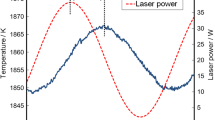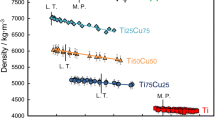Abstract
It was difficult to measure the volume change of alloy at high temperature, especially for undercooled solidification. In this paper, a novel method is proposed to measure the volume change of high temperature melt by high-frequency induction combined with the high-speed camera. The changes of liquid and solid volume of binary Ni–B and ternary Fe–Ni–B alloy with temperature were studied. The influence of the undercooling of the primary transition and eutectic transition on the volume change before and after solidification is discussed. It is found that both the solid and liquid volumes of Ni–B and Fe–Ni–B alloys decrease with decreasing temperature. For the primary transition (dendritic phase forms), the larger the undercooling, the more serious the volume shrinkage. For eutectic transformation (eutectic forms), the volume shrinkage decreases with the increase of undercooling.







Similar content being viewed by others
References
Dogan A, and Arslan H, Philos Mag 96 (2016) 2887. https://doi.org/10.1080/14786435.2016.1217361
Dogan A, and Arslan H, PhilosMag 98 (2018) 37. https://doi.org/10.1080/14786435.2017.1392053
Xu J F, Sun G Z, Liu Z T, Wang Y L, and Jian Z Y, Infrared Phys Technol 89 (2018) 59. https://doi.org/10.1016/j.infrared.2017.12.009
Watanabe S, Amatatu M, and Saito T, Trans Jpn Inst Met 12 (1971) 337. https://doi.org/10.2320/matertrans1960.12.337
Pstruś J, Moser Z, Gąsior W, & Dębski A, Arch Metall Mater, 51 (2006) 335. https://doi.org/10.1108/00035590610711723.
Shiraishi S Y, and Ward R G, Can Metall Q 3 (1964) 117. https://doi.org/10.1179/cmq.1964.3.1.117
Saito T, Shiraishi Y, and Sakuma Y, Trans Iron Steel Inst Jpn 9 (1969) 118. https://doi.org/10.2355/isijinternational1966.9.118
Saito T, & Sakuma Y, J Jpn Inst Metals, 22 (1970) 57. http://hdl.handle.net/10097/27518
Racz L M, and Egry I, Rev Sci Instrum 66 (1995) 4254. https://doi.org/10.1063/1.1145378
Bradshaw R C, Schmidt D P, Rogers J R, Kelton K F, and Hyers R W, Rev Sci Instrum 76 (2005) 125108. https://doi.org/10.1063/1.2140490
Chung S K, Thiessen D B, and Rhim W K, Rev Sci Instrum 67 (1996) 3175. https://doi.org/10.1063/1.1147584
Brillo J, and Egry I, Int J Thermophys 24 (2003) 1155. https://doi.org/10.1023/A:1025021521945
Brillo J, Egry I, and Matsushita T, Int J Mater Res 97 (2006) 28. https://doi.org/10.1515/ijmr-2006-0005
Schmon A, Aziz K, and Pottlacher G, Metall Mater Trans A 46 (2015) 2674. https://doi.org/10.1007/s11661-015-2844-1
Xu X L, Chen Y Z, and Liu F, Mater Lett 81 (2012) 73. https://doi.org/10.1016/j.matlet.2012.04.042
Xu X L, Zhao Y H, and Hou H, J Alloys Compd 773 (2019) 1131. https://doi.org/10.1016/j.jallcom.2018.09.228
Xu J F, Xiao Y, and Jian Z Y, Therm Anal Calorim 146 (2021) 2273. https://doi.org/10.1007/s10973-020-10424-4
Xu J F, Yang T, Li Z, Wang X, Xiao Y, and Jian Z Y, Sci Rep 10 (2020) 1380. https://doi.org/10.1038/s41598-019-56079-6
Acknowledgements
This work had no financial support.
Funding
The authors whose names are listed immediately below certify that they have NO affiliations with or involvement in any organization or entity with any financial interest (such as honoraria; educational grants; participation in speakers’ bureaus; membership, employment, consultancies, stock ownership, or other equity interest; and expert testimony or patent-licensing arrangements), or non-financial interest (such as personal or professional relationships, affiliations, knowledge or beliefs) in the subject matter or materials discussed in this manuscript.
Author information
Authors and Affiliations
Contributions
Junfeng Xu and Jitao Cao designed the project, analyzing the data and wrote the paper. Niu Tongzhuang, Yao Zhirui, Li Xuyang gave the discussions of the results and revised the paper. All authors read and approved the manuscript.
Corresponding author
Ethics declarations
Conflict of interest
The authors declare that they have no competing interests.
Additional information
Publisher's Note
Springer Nature remains neutral with regard to jurisdictional claims in published maps and institutional affiliations.
Rights and permissions
Springer Nature or its licensor (e.g. a society or other partner) holds exclusive rights to this article under a publishing agreement with the author(s) or other rightsholder(s); author self-archiving of the accepted manuscript version of this article is solely governed by the terms of such publishing agreement and applicable law.
About this article
Cite this article
Xu, J., Cao, J., Niu, T. et al. A Novel Method to Measure the High Temperature Melt Volume Change. Trans Indian Inst Met 76, 2701–2707 (2023). https://doi.org/10.1007/s12666-023-02960-y
Received:
Accepted:
Published:
Issue Date:
DOI: https://doi.org/10.1007/s12666-023-02960-y




